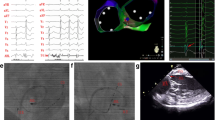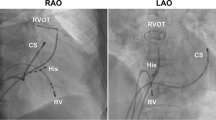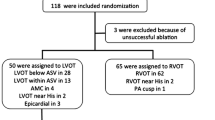Abstract
Objective
To assess the electrophysiological characteristics of the breakout site of ventricular activation using electroanatomical voltage mapping (EVM) and its relation to the optimal ablation site in idiopathic ventricular tachyarrhythmias originating from the outflow tract of the (RVOT) septum.
Methods
Twenty-eight patients with symptomatic drug-refractory premature ventricular complexes (PVCs) and/or ventricular tachycardia (VT) originating from the RVOT septum and 5 control subjects with WPW syndrome were included. Low-voltage areas (LVAs) were defined as signal amplitudes between 0.1 and 1.5 mV. The borderline between the normal area and the LVA was defined as “border,” and the distance from the LVA to the border (length of LVA) was measured.
Results
In all 28 patients and control subjects, there was an LVA below the pulmonary valve. There was no significant difference in length of LVA between patients with idiopathic ventricular arrhythmias and control subjects (2.0 ± 0.6 vs. 1.9 ± 0.1 cm). In 19 of the 28 patients, the optimal ablation site was identical to the border area. In all 11 patients who had pre-potentials at the successful ablation site, there were two cases with polymorphic VT and/or ventricular fibrillation associated with PVCs. In these two cases, length of LVA was longer than in other patients (4.0 and 3.9 cm vs. 1.8 ± 0.5 cm (n = 26)), and the optimal ablation site was located at the border area.
Conclusion
The border area, including the LVA, tends to be the breakout site and/or origin of ventricular arrhythmias in idiopathic ventricular tachyarrhythmia originating from the RVOT septum.



Similar content being viewed by others
References
Buxton, A. E., Waxman, H. L., Marchlinski, F. E., Simson, M. B., Cassdy, D., & Josephson, M. E. (1983). Right ventricular tachycardia: clinical and electrophysiologic characteristics. Circulation, 68(5), 917–927.
Morady, F., Kadish, A. H., DiCarlo, L., Kou, W. H., Winston, S., deBuitlier, M., et al. (1990). Long-term results of catheter ablation of idiopathic right ventricular tachycardia. Circulation, 82(6), 2093–2099.
Kamakura, S., Shimizu, W., Matsuo, K., Taguchi, A., Suyama, K., Kurita, T., et al. (1998). Localization of optimal ablation site of idiopathic ventricular tachycardia from right and left ventricular outflow tract by body surface ECG. Circulation, 98(15), 1525–1533.
Yamada, T., Murakami, Y., Yoshida, N., Okada, T., Shimizu, T., Toyama, J., et al. (2007). Preferential conduction across the ventricular outflow septum in ventricular arrhythmias originating from the aortic sinus cusp. Journal of the American College of Cardiology, 50(9), 884–891.
Boulos, M., Lashevsky, I., Reisner, S., & Gepstein, L. (2001). Electroanatomical mapping of arrhythmogenic right ventricular dysplasia. Journal of the American College of Cardiology, 38(7), 2020–2027.
Marchlinski, F. E., Zado, E., Dixit, S., Gerstenfeld, E., Callans, D. J., Hsia, H., et al. (2004). Electroanatomic substrate and outcome of catheter ablative therapy for ventricular tachycardia in setting of right ventricular cardiomyopathy. Circulation, 110(16), 2293–2298.
Corrado, D., Basso, C., Leoni, L., Tokajuk, B., Bauce, B., Frigo, G., et al. (2005). Three-dimensional electroanatomic voltage mapping increases accuracy of diagnosing arrhythmogenic right ventricular cardiomyopathy/dysplasia. Circulation, 111(23), 3042–3050.
Corrado, D., Basso, C., Leoni, L., Yokajuk, B., Turrini, P., Bauce, B., et al. (2008). Three-dimensional electroanatomical voltage mapping and histologic evaluation of myocardial substrate in right ventricular outflow tract tachycardia. Journal of the American College of Cardiology, 51(7), 731–739.
Iijima, K., Chinushi, M., Furushima, H., Hosaka, Y., Izumi, D., & Aizawa, Y. (2009). Ventricular fibrillation triggered during and after radiofrequency energy delivery to the site of origin of idiopathic right ventricular outflow tract arrhythmia. Pacing and Clinical Electrophysiology, 32(3), 406–9.
McKenna, W. J., Thiene, G., Nava, A., Fontaliran, F., Blomstrom-Lundqvist, C., Fontaine, G., et al. (1994). Diagnosis of arrhythmogenic right ventricular dysplasia/cardiomyopathy. Task Force of the Working Group Myocardial and Pericardial Disease of the European Society of Cardiology and of the Scientific Council on Cardiomyopathies of the International Society and Federation of Cardiology. British Heart Journal, 71(3), 215–218.
Yamashita, Y., Yagi, T., Namekawa, A., Ishida, A., Sato, H., Nakagawa, T., et al. (2009). Distribution of successful ablation sites of idiopathic right ventricular outflow tract tachycardia. Pacing and Clinical Electrophysiology, 32, 727–733.
Ouyang, F., Fotuhi, P., Volkmer, M., Goya, M., Burns, M., Ant, M., et al. (2002). Repetitive monomorphic ventricular tachycardia originating from the aortic sinus cusp: electrocardiographic characterization for guiding catheter ablation. Journal of the American College of Cardiology, 39(3), 500–508.
Franco, D., Lamers, W. H., & Moorman, A. F. (1998). Patterns of expression in the developing myocardium: towards a morphologically integrated transcriptional model. Cardiovascular Research, 38(4), 25–53.
Christoffels, V. M., Habets, P. E. M. H., Franco, D., Campione, M., de Jong, F., Lamers, W. H., et al. (2000). Chamber formation and morphogenesis in the developing mammalian heart. Developmental Biology, 223(2), 266–278.
Ruzicka, D. L., & Schwartz, R. J. (1988). Sequential activation of alpha-actin gene during avian cardiogenesis: vascular smooth muscle alpha-actin gene transcripts mark the onset of cardiomyocyte differentiation. The Journal of Cell Biology, 107(6), 2575–2586.
Moorman, A. F., & Christoffels, V. M. (2003). Cardiac chamber formation: development, genes, and evolution. Physiological Reviews, 83(4), 1223–1267.
Corrado, D., Basso, C., Thiene, G., McKenna, W. J., Davies, M. J., Fontaliran, F., et al. (1997). Spectrum of clinico-pathologic manifestations of arrhythmogenic right ventricular cardiomyopathy/dysplasia. A multicenter study. Journal of the American College of Cardiology, 30(6), 1512–1520.
Haissaguerre, M., Shoda, M., Jais, P., Nogami, A., Shah, D. C., Kautzner, J., et al. (2002). Mapping and ablation of idiopathic ventricular fibrillation. Circulation, 106(6), 962–967.
Aizawa, Y., Tamura, M., Chinushi, M., Niwano, S., Kusano, Y., Naitoh, N., et al. (1992). An attempt at electrical catheter ablation of the arrhythmogenic area in idiopathic ventricular fibrillation. American Heart Journal, 123(6), 257–260.
Noda, T., Shimizu, W., Taguchi, A., Aiba, T., Satomi, K., Suyama, K., et al. (2005). Malignant entity of idiopathic ventricular fibrillation and polymorphic ventricular tachycardia initiated by premature extrasystoles originating from the right ventricular outflow tract. Journal of the American College of Cardiology, 46(7), 1288–1294.
Author information
Authors and Affiliations
Corresponding author
Rights and permissions
About this article
Cite this article
Furushima, H., Chinushi, M., Iijima, K. et al. Relationship between electroanatomical voltage mapping characteristics and breakout site of ventricular activation in idiopathic ventricular tachyarrhythmia originating from the right ventricular outflow tract septum. J Interv Card Electrophysiol 33, 135–141 (2012). https://doi.org/10.1007/s10840-011-9623-8
Received:
Accepted:
Published:
Issue Date:
DOI: https://doi.org/10.1007/s10840-011-9623-8




